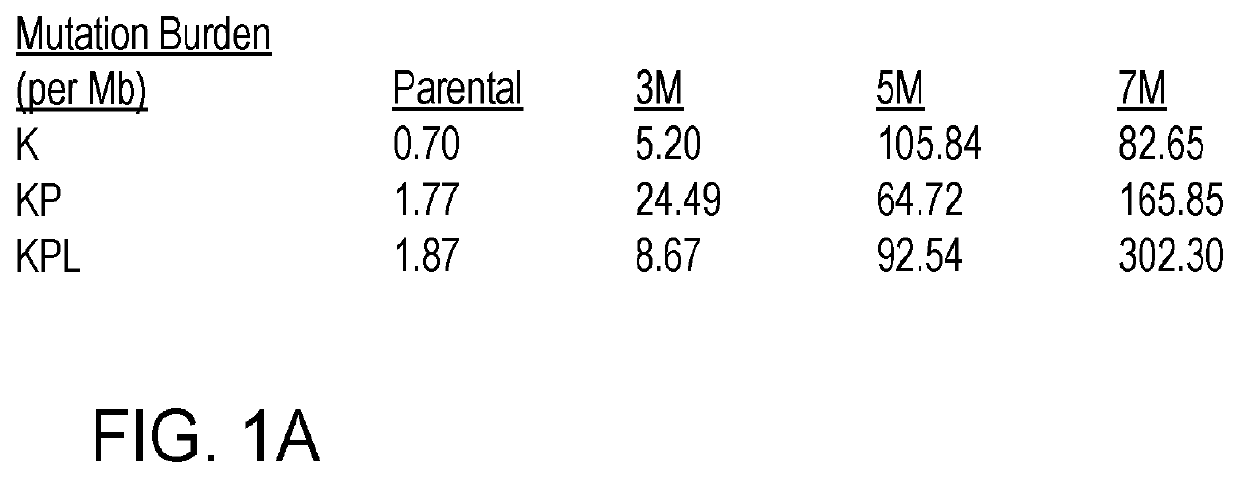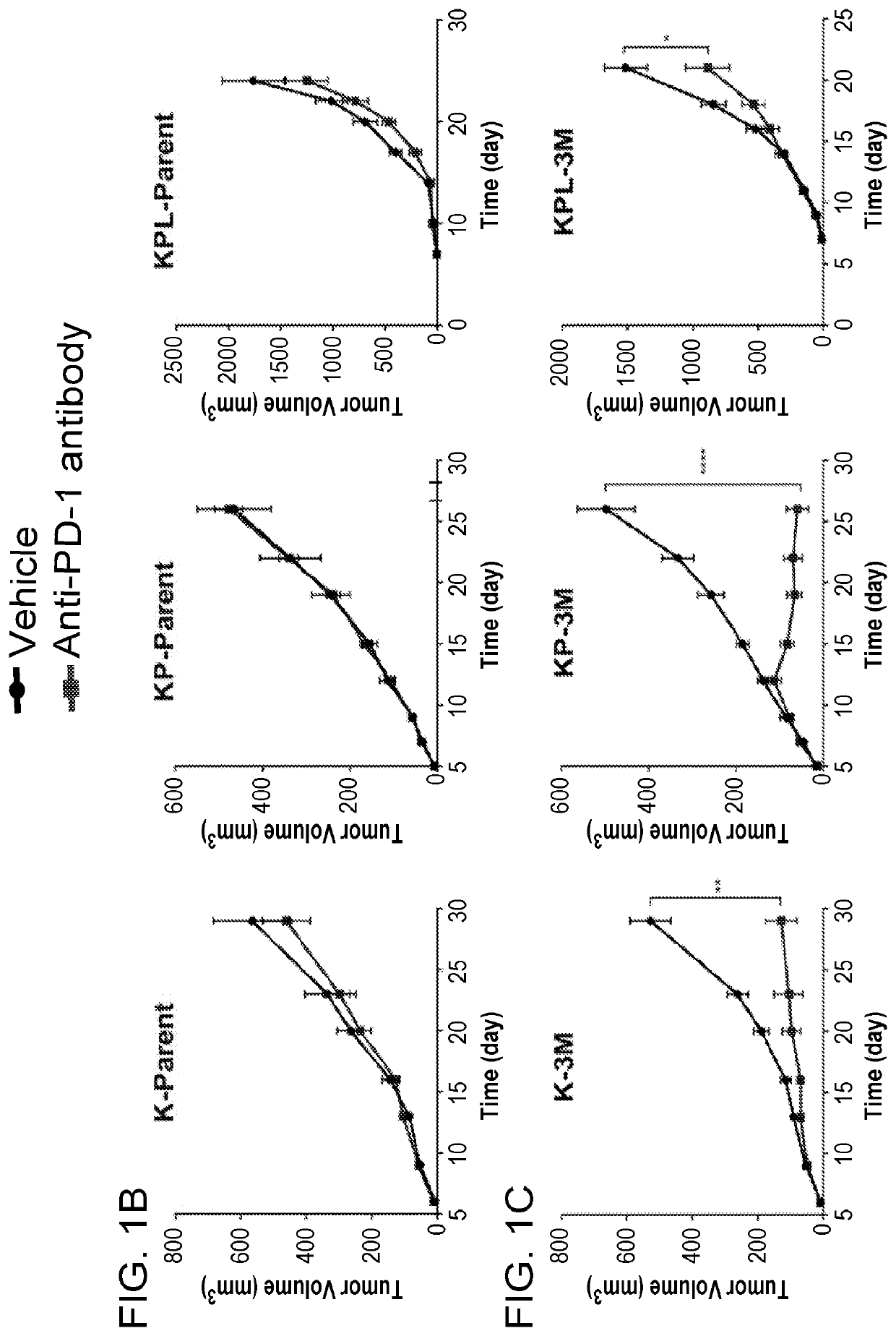Combination cancer therapy agents and methods
a cancer therapy agent and cancer technology, applied in the field of combination cancer therapy agents and methods, can solve the problems of significant toxicity and limited efficacy, patients with epidermal growth factor receptor (egfr) mutations and/or anaplastic lymphoma kinase (alk) rearrangements do not benefit from pd-1/pd-l1 inhibition after treatment, and the effect of reducing the number of patients
- Summary
- Abstract
- Description
- Claims
- Application Information
AI Technical Summary
Benefits of technology
Problems solved by technology
Method used
Image
Examples
example 1
ablished Genetically Engineered Murine Model (GEMM) of Lung Cancer Bearing Varying Mutational Loads Recapitulate Clinical Response to Anti-PD-1
[0125]Although conditional GEMMs of NSCLC bear common driver mutations of the disease, recent studies reveal that these GEMMs possess low tumor mutational burden (TMB). To recapitulate the mutational landscape of human NSCLC, we established novel GEMMs with increased TMB by in vitro exposure of KrasG12D (K), KrasG12DP53− / − (KP) and KrasG12DP53− / − Lkb1− / − (KPL) cells to carcinogen methyl-nitrosourea (MNU) for 30 min each time for 3, 5 or 7 times (designated as 3M, 5M, 7M, respectively). MNU is a potent alkylating agent that targets the nitrogen and oxygen atoms of nucleotides, resulting in transitions with similar numbers of G>A and C>T substitutions. Whole exome sequencing (WES) of these mutant cell lines revealed significant increases in mutational loads (FIG. 1A), as well as intratumoral heterogeneity. While tumors from all three parental c...
example 2
TME Immune Phenotypes Occur in GEMM Subtypes
[0127]Responses to anti-PD-1 therapy require pre-existing tumor-specific T cell immunity that is restrained by PD-L1 / PD-1-mediated suppression. Consistent with the observation that KRAS-driven lung cancers with LKB1-inactivating mutations are resistant to anti-PD-1 therapy, our immune profiling of the tumor microenvironment (TME) of the GEMMs by flow cytometry revealed significant infiltration of T lymphocytes in K-3M and KP-3M tumors but a lack of CD4+ and CD8+ T cell infiltration in KPL-P and KPL-3M tumors, indicative of a state of suppressed T cell immunity (FIG. 2A). In contrast, we observed a predominance of myeloid derived suppressor cells (MDSCs) within the TME of KPL-P and KPL-3M (FIG. 2B), consistent with the previous studies. As anticipated, the profound state of immunosuppression in KPL-P and KPL-3M tumors with low T lymphocyte infiltration correlates with low PD-L1 expression, which is associated with primary resistance to anti...
example 3
Efficacy of Anti-PD-1 by IT Administration of CXCL9 / 10-DC in a Murine Lung Cancer Model
[0129]For the studies described herein, DC were transduced with a lentiviral construct expressing murine CXCL9 and, separately, other DC were transduced with a lentiviral construct expressing murine CXCL10. The nucleotide sequence for CXCL9 (SEQ ID NO: 6) was obtained based on the sequence provided in SEQ ID NO:2. PCR products of CXCL9 were generated and “sticky ends” generated through restriction digestion. These products were then ligated onto a lentiviral vector. This vector was then transfected with helper vectors onto 293T cells to generate lentivirus containing CXCL9 protein expression which were subsequently used to infect dendritic cells for delivery into the tumor. CXCL10-DCs were generated using a similar process using the nucleotide sequence (SEQ ID NO:8) based on SEQ ID NO:4. These DCs were referred to herein as CXCL9 / 10-DC (or vector-CXCL9 / 10-DC). As noted herein, for each DC populati...
PUM
| Property | Measurement | Unit |
|---|---|---|
| time | aaaaa | aaaaa |
| intratumoral heterogeneity | aaaaa | aaaaa |
| resistance | aaaaa | aaaaa |
Abstract
Description
Claims
Application Information
 Login to View More
Login to View More - R&D Engineer
- R&D Manager
- IP Professional
- Industry Leading Data Capabilities
- Powerful AI technology
- Patent DNA Extraction
Browse by: Latest US Patents, China's latest patents, Technical Efficacy Thesaurus, Application Domain, Technology Topic, Popular Technical Reports.
© 2024 PatSnap. All rights reserved.Legal|Privacy policy|Modern Slavery Act Transparency Statement|Sitemap|About US| Contact US: help@patsnap.com










